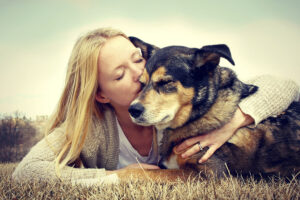
Amputation of the hind limb is an unfortunate situation for any pet and their owners, but recovery is possible!
For many pet owners, the thought of their beloved dog undergoing an amputation is daunting. However, whether due to injury, disease, or a congenital condition, dogs can adapt remarkably well to life on three legs. With proper care, rehabilitation, and support, they can continue to lead active, happy lives. Even with amputation of the hind limb, you will be amazed at how comfortably your dog can live their life.
Reasons for Hind Limb Amputation
Hind limb amputation in dogs is often performed as a life-saving measure. Common reasons include:
- Cancer: Osteosarcoma and other aggressive bone cancers often necessitate amputation to prevent spread and alleviate pain.
- Severe Trauma: Accidents, fractures, or irreparable injuries from car accidents or falls may require amputation.
- Infections: Chronic infections that do not respond to treatment can lead to the need for limb removal.
- Congenital Defects: Some dogs are born with limb deformities that make amputation the best option for mobility and comfort.
How Dogs Adapt to Three Legs
Dogs are naturally resilient and, with time, adjust well to three-legged mobility. Some key adaptations include:
- Weight Redistribution: Dogs shift their weight to the remaining limbs, primarily using their front legs for support and balance.
- Improved Strength and Coordination: Over time, their muscles and joints adapt to accommodate the change.
- Mental Resilience: Dogs do not dwell on their missing limb; they rely on their instincts to move forward and adjust to their new reality.
Helping Your Dog Thrive After Amputation
A dog’s recovery and adaptation after a hind limb amputation depend largely on the care they receive. Here are some essential tips:
Post-Surgery Care
- Follow your veterinarian’s instructions for pain management and wound care.
- Monitor for signs of infection or complications at the surgical site.
- Encourage rest and limit activity until your vet advises otherwise.
Physical Rehabilitation
- Gentle exercises, such as slow leash walks, can help your dog build strength and confidence.
- Hydrotherapy (swimming) is an excellent low-impact exercise for mobility and muscle development.
- Balance and coordination training can help your dog adjust to life on three legs.
Home Adjustments for Comfort
- Provide non-slip flooring to help prevent falls and injuries.
- Use orthopedic bedding to support joints and prevent pressure sores.
- Consider a harness with a handle to assist with movement, especially in the early recovery phase.
Emotional and Social Support
- Give your dog plenty of affection and encouragement as they adjust.
- Maintain a regular routine to help them feel secure.
- Allow them to socialize and play as they normally would—dogs are highly adaptable and will learn to navigate their world with confidence.
TriPawds: Supporting Three-Legged Pets and Their Owners
For pet owners facing the journey of caring for a three-legged dog after amputation, organizations like TriPawds provide invaluable support and resources. TriPawds is a community-driven platform dedicated to helping amputee pets and their owners navigate life after limb loss. Founded by Jim Nelson and Rene Agredano, who experienced their dog’s journey through amputation, TriPawds offers a wealth of information, support forums, and inspirational stories.
Community and Resources
TriPawds serves as a supportive community where pet owners can connect, share experiences, and find encouragement from others facing similar challenges. The platform features:
- Forums and Support Groups: Dedicated forums allow members to ask questions, seek advice, and share their stories. Whether it’s tips on rehabilitation exercises, emotional support during recovery, or practical advice on mobility aids, TriPawds members offer compassionate insights and firsthand knowledge.
- Educational Resources: From articles on post-amputation care to videos demonstrating exercises and mobility aids, TriPawds provides comprehensive resources to empower pet owners in caring for their three-legged companions.
- Success Stories and Inspiration: TriPawds celebrates the resilience of amputee pets through success stories that highlight how these animals thrive post-amputation. These stories not only inspire hope but also provide practical examples of what can be achieved with love, dedication, and proper care.
Support for Pet Owners
Beyond the practical guidance, TriPawds emphasizes the emotional well-being of pet owners. Coping with a pet’s amputation can be emotionally challenging, and TriPawds encourages a positive outlook through:
- Emotional Support: Providing a platform where owners can express their feelings openly and receive empathy and support from others who understand the journey.
- Guidance on Adjustment: Helping owners navigate the initial adjustment period and offering strategies for creating a supportive environment at home.
Advocacy and Awareness
TriPawds also advocates for greater awareness and understanding of amputation in pets. By sharing stories of resilience and promoting education about amputation alternatives and post-operative care, TriPawds aims to reduce stigma and ensure that amputee pets receive the care and respect they deserve.
Success Stories: Dogs Living Their Best Lives
Many three-legged dogs (often called “tripods”) go on to lead fulfilling lives. Whether running, playing, hiking, or simply enjoying a comfortable life at home, these resilient canines prove that amputation does not limit their happiness or quality of life. With love, patience, and the right care, dogs with a hind limb amputation can continue to thrive and enjoy a long life.
Trust Maryland Veterinary Surgical Services With Your Companion’s Health
Your companion’s health is important, and the team at MVSS is ready to provide the best care possible for your furry family. We are dedicated to combining comprehensive exams and assessments with informative and honest discussions of your companion’s care. Once we have worked with you to decide on the best course of action for your dog, our professionals will use their surgical expertise to work towards the goal of giving your companion an active and pain-free life. We are proud to serve loyal companions in Catonsville and Baltimore. To learn more about our services, give us a call at 410-788-4088 or visit us online. For more information and tips for dog health, follow us on Facebook and Pinterest.
